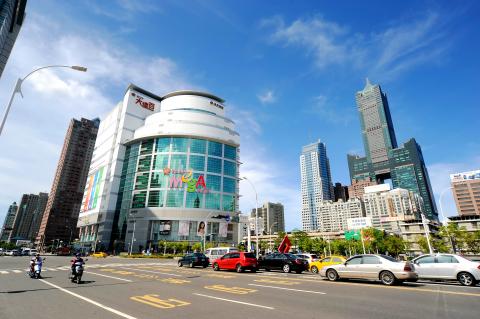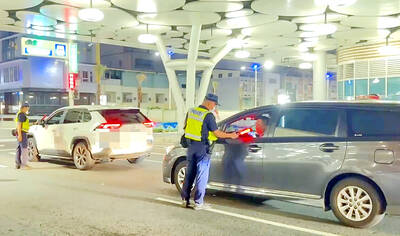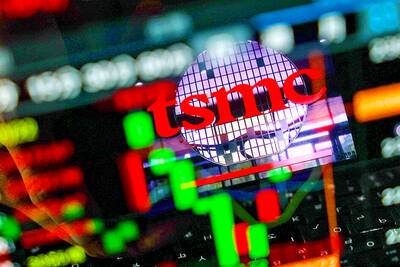Prompted by questions posed by foreign tourists, residents are now pondering Greater Kaohsiung’s apparent listless atmosphere and the lack of economic activity in the southern port city.
Recently, questions posted on the Mobile01 Web site by a group of backpackers from Malaysia (“What is happening to Kaohsiung? Why are there so few people on the streets?”) generated lively on-line debates and elicited much response.
In addition, Kaohsiung is barely mentioned on one popular backpacker information Web site.

Photo: Chang Chung-i, Taipei Times
In response, one netizen wrote: “[If I had] to recommend a place to visit in southern Taiwan, it would be Tainan or Kenting, because those cities have more special characteristics than Kaohsiung.”
Another netizen responded by saying: “Kaohsiung is a growing city making steady progress, but there is still a lack of jobs and little population growth.”
Others said: “There are so few passengers on the Kaoshiung MRT, and you don’t see much major construction or business activities.”
Defending the city’s reputation, several individuals wrote: “I really like Kaohsiung, just because it is not so crowded, has a slower pace of life, while it does offer the convenience and prosperity of a big city.”
Another replied: “There are so many good places to visit around Kaohsiung, like the harbor area, Chaishan Park (柴山), Cijin (旗津) Fishery Port, the World Games Stadium, Heart of Love River (愛河之心) and others. You would need more than a day to visit each of these famous tourist sites.”
A local restaurant owner, surnamed Chen (陳), said that Kaohsiung’s economy is struggling, and that he has lost between 20 percent and 30 percent of his business compared with previous years. He noticed that not many people are on the streets after 9pm.
A night market vendor, surnamed Su (蘇), contended that to revive the economy, the city should not depend on tourists from China.
He said that most people are constrained in their activities by the stagnant economy and are cutting their spending. So, instead of asking: “What is happening to Kaohsiung?” the question should be: “What is happening to Taiwan?”
An official from Greater Kaohsiung’s Economic Development Bureau replied that the bureau respects the views expressed in the online discussion sites, but in reality it is not just Kaohsiung, but the whole of Taiwan that is affected by a weak economy.
He said this has affected people’s willingness to travel, shop and spend money on goods.
He said that the economy is forecast to improve in the near future and once the port facility expansion project, Kaohsiung Asia New Harbor (亞洲新灣區), is completed, Kaohsiung will experience a new period of economic growth.
One bright spot this year is the Kaohsiung Pier 2 Art District (駁二藝術特區) which, according to its own data, attracted more than 1.9 million visitors from January to this month, surpassing visitor numbers for the whole of last year.
Its own survey results indicated many visitors were backpackers from Hong Kong, Macau, Singapore and Malaysia.
The Greater Kaohsiung Government pointed out that major tourist attractions have set new highs for visitor numbers in the first half of this year.
Topping the list is the Fo Guang Shan Monastery (佛光山), with more than 6.69 million visitors, far ahead of other scenic sites around Kaohsiung.
A total of 18 major tourist attractions were categorized in an analysis of economic activities of Greater Kaohsiung, undertaken on behalf of the local government.
These included Maolin Scenic Area, the Baolai Hot Springs Area, Shoushan Zoo, the Former British Consulate at Takao, the Kaohsiung Museum of Fine Arts, the Meinung Hakka Culture Museum, Cheng Ching Lake Scenic Area, Fo Guang Shan Monastery, the Yang Min Museum of Marine Exploration, the National Science and Technology Museum, the Heart of Love River, Cijin Fishery Port and Kaohsiung Pier 2 Art District.
For these 18 major Kaohsiung tourist attractions, visitor numbers have gone up from 8.07 million in 2008 to 12.48 million last year. Visitor numbers have already reached 16.28 million for the first half of this year, higher than the whole of last year.
Of all attractions, Fo Guang Shan Monastery has the most impressive numbers, with 6.59 million for the first half of this year, followed by Cijin Fishery Port with 2.7 million. In third place is the Kaohsiung Pier 2 Art District with 2.7 million and the National Science and Technology Museum is ranked fourth with 1.39 million for the same period.
The hotel occupancy rate in Kaohsiung was 64.96 percent for the first half of this year, higher than the 61.92 percent recorded during the same period last year.
Tourism bureau information indicated that most of the increase was due to 83,000 Chinese tourists who visited in the second quarter of this year, followed in second place by 50,000 Japanese tourists.

TRAFFIC SAFETY RULES: A positive result in a drug test would result in a two-year license suspension for the driver and vehicle, and a fine of up to NT$180,000 The Ministry of Transportation and Communications is to authorize police to conduct roadside saliva tests by the end of the year to deter people from driving while under the influence of narcotics, it said yesterday. The ministry last month unveiled a draft of amended regulations governing traffic safety rules and penalties, which included provisions empowering police to conduct mandatory saliva tests on drivers. While currently rules authorize police to use oral fluid testing kits for signs of drug use, they do not establish penalties for noncompliance or operating procedures for officers to follow, the ministry said. The proposed changes to the regulations require

Taipei, New Taipei City, Keelung and Taoyuan would issue a decision at 8pm on whether to cancel work and school tomorrow due to forecasted heavy rain, Keelung Mayor Hsieh Kuo-liang (謝國樑) said today. Hsieh told reporters that absent some pressing reason, the four northern cities would announce the decision jointly at 8pm. Keelung is expected to receive between 300mm and 490mm of rain in the period from 2pm today through 2pm tomorrow, Central Weather Administration data showed. Keelung City Government regulations stipulate that school and work can be canceled if rain totals in mountainous or low-elevation areas are forecast to exceed 350mm in

The Executive Yuan yesterday announced that registration for a one-time universal NT$10,000 cash handout to help people in Taiwan survive US tariffs and inflation would start on Nov. 5, with payouts available as early as Nov. 12. Who is eligible for the handout? Registered Taiwanese nationals are eligible, including those born in Taiwan before April 30 next year with a birth certificate. Non-registered nationals with residence permits, foreign permanent residents and foreign spouses of Taiwanese citizens with residence permits also qualify for the handouts. For people who meet the eligibility requirements, but passed away between yesterday and April 30 next year, surviving family members

1.4nm WAFERS: While TSMC is gearing up to expand its overseas production, it would also continue to invest in Taiwan, company chairman and CEO C.C. Wei said Taiwan Semiconductor Manufacturing Co (TSMC) has applied for permission to construct a new plant in the Central Taiwan Science Park (中部科學園區), which it would use for the production of new high-speed wafers, the National Science and Technology Council said yesterday. The council, which supervises three major science parks in Taiwan, confirmed that the Central Taiwan Science Park Bureau had received an application on Friday from TSMC, the world’s largest contract chipmaker, to commence work on the new A14 fab. A14 technology, a 1.4 nanometer (nm) process, is designed to drive artificial intelligence transformation by enabling faster computing and greater power